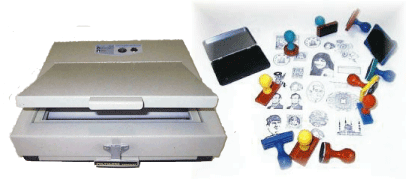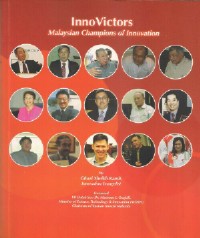

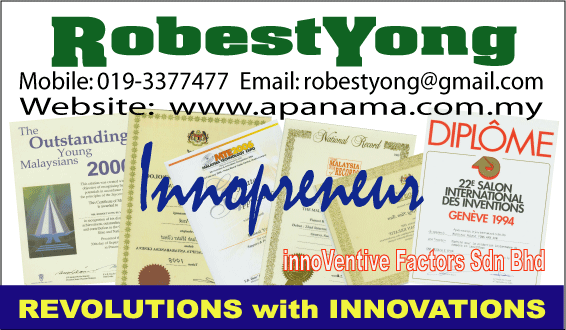
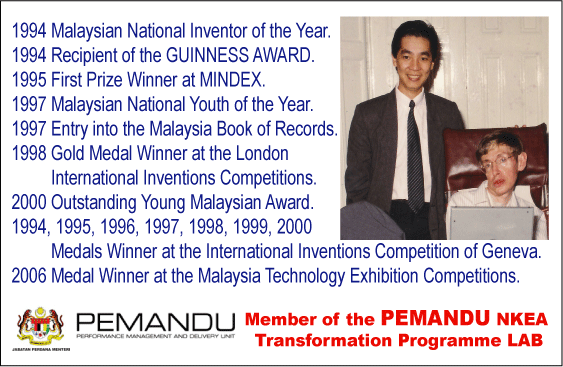

RobestYong
robestyong@gmail.com
robestyong@gmail.com
You are my Guest
Send me an Email
Blip my Blog
Follow my Tweets
Be my FACEBOOK friend
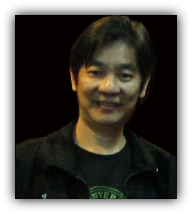



de STORY
Adopted from InnoVictors - Malaysian Champions of Innovation
As told by Dato' Ghazi Sheikh Ramli,
the Innovation Evangelist of Malaysia
As told by Dato' Ghazi Sheikh Ramli,
the Innovation Evangelist of Malaysia
Dato' Ghazi Sheikh Ramli
A former Malaysian Senator who's passionate in creativity and innovation led him to be the Founder / President of Malaysian Association of Creativity and Innovation (MACRI)
A former Malaysian Senator who's passionate in creativity and innovation led him to be the Founder / President of Malaysian Association of Creativity and Innovation (MACRI)
There are many motivating factors behing innovation, but for RobestYong, it was his poor beginings that first fueled his desire for innovation. His desire to invent things had its roots from his early days as a child coming from a poor family, when things were scarce at home.
“I have eleven brothers and sisters,” he says. We lived in a rubber estate and we were quite isolated, so we made our own toys. Since I was young, I’ve had a passion for handiwork.”
His first job was at a company that sold printing machines where he learned how to repair the machines. In 1980, his company sent him to Japan for two years. RobestYong says it was a good apprentice program for him and he learned a lot from his time in Japan.
He came back armed with practical experience and returned a much more confident man. Robest stayed with the company until 1987, when he felt compelled to be out on his own. Nevertheless, he was practical enough to continue offering his services on a freelance basis. While he was still repairing the machines to help pay the bills, he slowly built up his own company.
His first job was at a company that sold printing machines where he learned how to repair the machines. In 1980, his company sent him to Japan for two years. RobestYong says it was a good apprentice program for him and he learned a lot from his time in Japan.
He came back armed with practical experience and returned a much more confident man. Robest stayed with the company until 1987, when he felt compelled to be out on his own. Nevertheless, he was practical enough to continue offering his services on a freelance basis. While he was still repairing the machines to help pay the bills, he slowly built up his own company.
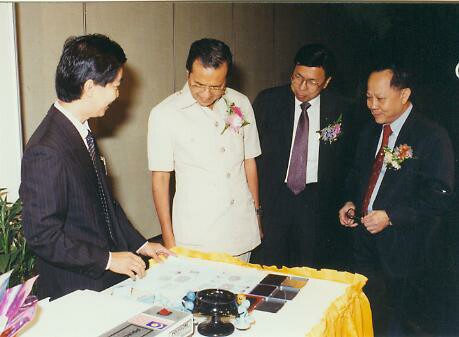
His first claim to fame was the instant rubber stamp machine, which has since revolutionized the way rubber stamps are made. The idea first came to him when he wanted to start his own company. “Everybody needs to get a rubber stamp,” he says. “But I noticed it took so long to make them - up to a week. I felt this process could be improved.”
So, he set about to do something about it. While in Japan he had noticed a printing technology using a photo-polymer that he believed could be used for his instant rubber stamp device.
In creating the prototype he realised that photopolymers were not suitable for making rubber stamps, so he went to Japan to find out if it was possible to adjust the formula to fit his needs. He found his answer there. The material he used for the stamp is not natural rubber but Polyclone, a polymer that looks like transparent rubber.
So, he set about to do something about it. While in Japan he had noticed a printing technology using a photo-polymer that he believed could be used for his instant rubber stamp device.
In creating the prototype he realised that photopolymers were not suitable for making rubber stamps, so he went to Japan to find out if it was possible to adjust the formula to fit his needs. He found his answer there. The material he used for the stamp is not natural rubber but Polyclone, a polymer that looks like transparent rubber.
The Prime Minister, Dr. Mahathir Mohammad launching the Polyclone Instant Rubber Stamp Machine at the Wisma MCA in 1994.
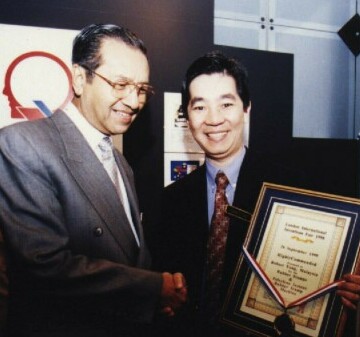
Being congratulated by Tun Dr. Mahathir Mohammad for winning the Gold Medal at the London International Invention Competition in 1997
But Robest says that over the years, he’s had his fair share of devices that were functional but were not commercial successes. An example is the Kamikaze Mosquito Attractant Glue, which is a small device that attracts mosquitoes to a sticky substance which then traps them. He actually won a medal in Geneva for it but failed to take it off commercially.
Robest also has a penchant for thinking outside the box. His ABL Automatic Car Braking System is a system that Yong interestingly describes as the opposite to auto-cruise”. The system keeps the brakes continuously on once you brake the car until you press the accelerator, which is quite the opposite of auto-cruise. He proposed the system to a local carmaker but was declined by them because it was something unheard of for them.
But RobestYong is not one to be daunted by commercial failures. He is currently focused on his latest product, the Green Whizzard Probiotic Fertilizer. This idea came to him when he first moved into his new house. He wanted to use plants to landscape his lawn but when he went to the nurseries to get fertilizers he noticed all of them were in big bags and were inefficient in doing their jobs.
In 1993, the product was finally ready and brought to market. “It was not difficult to sell the product because the results are there for you to see, it wasn’t a conceptual thing. It could create a rubber stamp in 10 minutes,” he says.
The next year, he won a gold medal for that product in the International lnvention Competition in Geneva and he returned a local hero, with lauded by strong newspaper coverage.
‘People used to laugh at my product because they couldn’t believe I was the first to create something like this,” he says. “They thought surely someone overseas would have already come up with it.”
Yong’s machine saw international interest soon after it won the gold medal in Geneva as he was approached by product scouts looking for distribution rights almost immediately after the competition. Today, the machine is marketed both locally and internationally in countries such as Russia, Japan, US and in Africa.
Still, he regards commercialisation as one of his biggest challenges. “I’m not good at marketing... most inventors aren’t,” he says. “However, inventors should not invent something that is not commercially viable.”
The next year, he won a gold medal for that product in the International lnvention Competition in Geneva and he returned a local hero, with lauded by strong newspaper coverage.
‘People used to laugh at my product because they couldn’t believe I was the first to create something like this,” he says. “They thought surely someone overseas would have already come up with it.”
Yong’s machine saw international interest soon after it won the gold medal in Geneva as he was approached by product scouts looking for distribution rights almost immediately after the competition. Today, the machine is marketed both locally and internationally in countries such as Russia, Japan, US and in Africa.
Still, he regards commercialisation as one of his biggest challenges. “I’m not good at marketing... most inventors aren’t,” he says. “However, inventors should not invent something that is not commercially viable.”
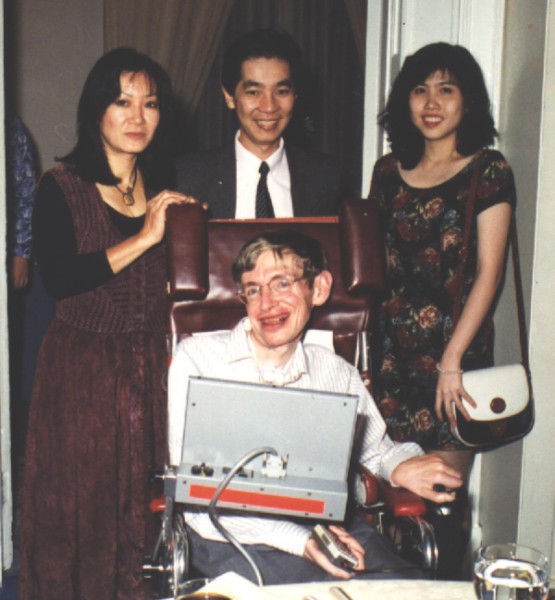
“Every product has shortcomings,” he says. “I wanted to come out with something better.”
“Every product has shortcomings,” he says. “I wanted to come out with something better.”
Upon conducting research, he stumbled upon an enzyme that was being used in the U.S.A. food industry that could make micro-organisms multiply. By multiplying organisms in the soil, he could make better fertilizers.
To develop the product, RobestYong collaborated with University of Technology Mara in Shah Alam to undertake research and development into formulating a new type of fertilizer that utilises the probiotic enzymes he found in the U.S.A. food industry.
Upon conducting research, he stumbled upon an enzyme that was being used in the U.S.A. food industry that could make micro-organisms multiply. By multiplying organisms in the soil, he could make better fertilizers.
To develop the product, RobestYong collaborated with University of Technology Mara in Shah Alam to undertake research and development into formulating a new type of fertilizer that utilises the probiotic enzymes he found in the U.S.A. food industry.
A moment in time with Prof. Stephen Hawkins
Green Whizzard is a highly concentrated, nutrient-enriched product that provides fast, clean, convenient and hygienic fertilizing. RobestYong says it is an environmentally-friendly product that formulates nutrients to stimulate the growth of micro-organisms in the soil which are essential for breaking up nutrients and unlocking previously applied fertilizers which had been lying dormant.
According to Yong, conventional fertilizer often brings more harm than good to the soil. When excess fertilizer is applied and not broken or used by the plants, it will stay dormant in the soil. Too much of it in the soil will make the soil toxic and considered “dead soil”. To solve this problem, Green Whizzard adds living micro-organisms into the soil through the enzyme.
What you are likely to purchase from the nurseries or department stores comes in big bulky bags and sometimes smell like dung, which is what they are actually made of. Green Whizzard is formulated from natural, enriched minerals and marketed in a very convenient package,” he says.
Yong explains that you simply put a little of the powder from the bottle onto the roots of the plants, water it down well and repeat the process every two weeks. When the plants start showing signs of improvement, you only need to apply the powder once a month instead of fortnightly.
Best of all, Green Whizzard is cost-efficient, says Robest. While other fertilizers might sell at lower prices, they might consist of 90% filler and only 10% of actual useful materials.
“You are basically paying for the extra weight, the bulky storage and transportation and a lot of ‘rubbish’ in the bag,” says Robest. “Green Whizzard is in the most concentrated form. Only a few grams a month is enough to keep a plant green and healthy. A bottle can do over 200 puffs, which means you can use it for over eight years on one plant! How’s that for saving?”
The results can be seen very quickly - as early as two weeks. The first noticeable result is in the leaves. They will become bigger, greener and thicker. The flowers will have brighter and more vibrant colours and the fruits will be larger and bountiful. The overall plant will be healthier and more productive.
The product is targeted at household gardeners, nurseries, orchard owners as well as small farmers. It is suitable for all types of vegetables, flowers, fruits, hedges, creepers, bonsai, ferns, lawn grass, aquatic and ornamental plants.
Today, he is one of the country’s most celebrated inventors. He has about half a dozen inventions to his name, all of which have won local and global acclaim.
He is a frequent winner for national level awards almost yearly and has won medals at the International Invention Exhibition in Geneva all the way from 1994 to 1999. Robest believes everybody has some form of creativity. It just needs to be unlocked in order for them to become inventors - a point he loves to stress in his talks to students around the country.
“Usually when I get asked to give a talk to young people, I will accept,” he says. “I do not expect payment for this. I do not even ask for petrol allowance,” he adds with a smile.
He has some advice for young people. Firstly, since inventions are often inspired by the things you see and experience in every day life, he recommends writing things down when they see something interesting. “You might not need the information or idea now but it could be useful later on.”
Secondly, he says that budding inventors must be realistic. “It is good to dream but you must be realistic too. You can’t just keep on dreaming, you need to create something that works,” he says.
Realistic also means that the invention must be commercially viable. “If you think your product is workable but has no commercial value, it is better not to pursue it,” he says.
But he adds that it is not the same thing as abandoning it. “Keep it, store it, but do not pursue it at this point in time because it is not commercially viable. One day, it might become more feasible to commercialize the idea,” he says.
“Usually when I get asked to give a talk to young people, I will accept,” he says. “I do not expect payment for this. I do not even ask for petrol allowance,” he adds with a smile.
He has some advice for young people. Firstly, since inventions are often inspired by the things you see and experience in every day life, he recommends writing things down when they see something interesting. “You might not need the information or idea now but it could be useful later on.”
Secondly, he says that budding inventors must be realistic. “It is good to dream but you must be realistic too. You can’t just keep on dreaming, you need to create something that works,” he says.
Realistic also means that the invention must be commercially viable. “If you think your product is workable but has no commercial value, it is better not to pursue it,” he says.
But he adds that it is not the same thing as abandoning it. “Keep it, store it, but do not pursue it at this point in time because it is not commercially viable. One day, it might become more feasible to commercialize the idea,” he says.
Lastly, do not invent a problem to solve a problem. ‘I’m referring to solutions that create more problems,” says Yong. “It is a common thing for inventors to come with solutions that create problems that are actually bigger than the original problem. That is self-defeating.”
The Polyclone Instant Robber Stamp machine which is capable of producing rubber stamps in 5 minutes using plain tap water as the etching agent.
Thinking Without the Box...













































